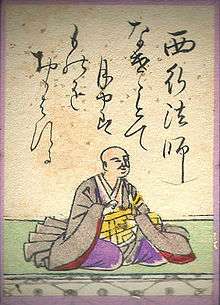Saigyō
| Saigyō Hōshi (西行 法師) | |
|---|---|
 Saigyō Hōshi in the Hyakunin Isshu | |
| Born |
Satō Norikiyo (佐藤 義清) 1118 Kyoto |
| Died | 1190 (aged 71–72) |
| Pen name | Saigyō |
| Occupation | Poet |
| Nationality | Japanese |
Saigyō Hōshi (西行 法師, 1118 – March 23, 1190) was a famous Japanese poet of the late Heian and early Kamakura period.
Biography
Born Satō Norikiyo (佐藤 義清) in Kyoto to a noble family, he lived during the traumatic transition of power between the old court nobles and the new samurai warriors. After the start of the Age of Mappō (1052), Buddhism was considered to be in decline and no longer as effective a means of salvation. These cultural shifts during his lifetime led to a sense of melancholy in his poetry. As a youth, he worked as a guard to retired Emperor Toba, but in 1140 at age 22, for reasons now unknown, he quit worldly life to become a monk, taking the religious name En'i (円位). He later took the pen name, "Saigyō" meaning Western Journey, a reference to Amida Buddha and the Western paradise. He lived alone for long periods in his life in Saga, Mt Koya, Mt Yoshino, Ise, and many other places, but he is more known for the many long, poetic journeys he took to Northern Honshū that would later inspire Bashō in his Narrow Road to the Interior. He was a good friend of Fujiwara no Teika. Some main collections of Saigyō's work are in the Sankashū, Shin Kokin Wakashū, and Shika Wakashū. He died in Hirokawa Temple in Kawachi Province (present-day Osaka Prefecture) at age 72.
Style
In Saigyō's time, the Man'yōshū was no longer a big influence on waka poetry, compared to the Kokin Wakashū. Where the Kokin Wakashū was concerned with subjective experience, word play, flow, and elegant diction (neither colloquial nor pseudo-Chinese), the Shin Kokin Wakashū (formed with poetry written by Saigyō and others writing in the same style) was less subjective, had fewer verbs and more nouns, was not as interested in word play, allowed for repetition, had breaks in the flow, was slightly more colloquial and more somber and melancholic. Due to the turbulent times, Saigyō focuses not just on mono no aware (sorrow from change) but also on sabi (loneliness) and kanashi (sadness). Though he was a Buddhist monk, Saigyō was still very attached to the world and the beauty of nature.
Poetry examples

- Many of his best-known poems express the tension he felt between renunciatory Buddhist ideals and his love of natural beauty.
願わくは花の下にて春死なむ その如月の望月のころ
{{{2}}}
ねがわくは はなのもと(した)にてはるしなむ そのきさらぎの もちづきのころ, negawaku wa, hana no moto(shita)nite haru shinamu, sono kisaragi no mochizuki no koro.
Let me die in spring under the blossoming trees, let it be around that full moon of Kisaragi month.
([1])Most monks would have asked to die facing West, to be welcomed by the Buddha, but Saigyō finds the Buddha in the flowers.
To be "heartless" was an ideal of Buddhist monkhood, meaning one had abandoned all desire and attachment.心無き身にも哀れは知られけり
鴫立つ沢の秋の夕暮れ
kokoro naki mi ni mo aware wa shirarekeri shigi tatsu sawa no aki no yūgure
Even a person free of passion would be moved to sadness: autumn evening in a marsh where snipe fly up.
([2]) - Saigyō travelled extensively, but one of his favorite places was Mount Yoshino, famous for its cherry blossoms.
吉野山こぞのしをりの道かへて
まだ見ぬかたの花をたづねむ
yoshino yama kozo no shiori no michi kaete mada minu kata no hana wo tadzunemu
I'll forget the trail I marked out on Mount Yoshino last year, go searching for blossoms in directions I've never been before.
([3])
See also
- Touhou Project - the character Yuyuko Saigyōji is suggested to be Saigyō's daughter.
| Wikimedia Commons has media related to Saigyō. |
Resources
- Saigyô, Poems of a Mountain Home, translated by Burton Watson, Columbia University Press, 1991 ISBN 0-231-07492-1 cloth ISBN 0-231-07493-X pbk [233 pp.]
- Saigyô, Mirror for the Moon: A Selection of Poems by Saigyô (1118-1190), translated by William R. LaFleur, New Directions 1978.
- William R. LaFleur. Awesome Nightfall: The Life, Times, and Poetry of Saigyō. Boston: Wisdom Publications, 2003 ISBN 0-86171-322-2 pbk [177 pp] This is an expanded and matured reworking of the material in Mirror for the Moon.
References
External links
- Classical Japanese Database - has some poems by Saigyō in translations and in the original Japanese
- digital 西行庵
- 山家集の研究
|